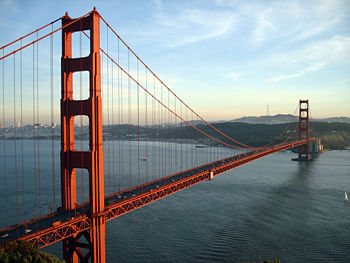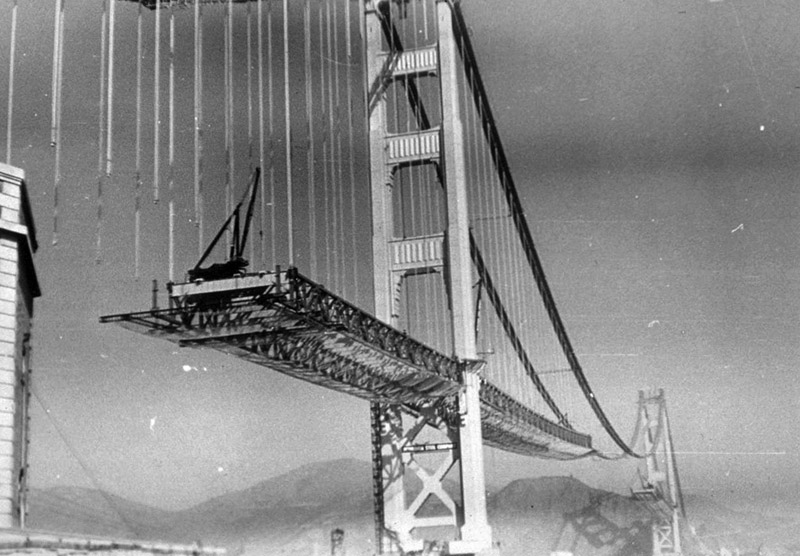The Golden Gate Bridge is perhaps the most iconic part of San Francisco, California. Built in 1933-1937, it is still standing in good shape today with over ten million visitors annually. The American Society of Civil Engineers even made it one of the Seven Wonders of the Modern World. From it’s opening in 1937 until 1964, the Golden Gate Bridge was the longest bridge in the world, with a span of 4,200 feet. It has a width of 90 feet and a height of 746.
Prior to the opening of the Golden Gate Bridge, there was only one way to get from San Francisco to Marin County, and it was by ferry. There was high demand for a bridge to be built to make for easier transportation between the two. However, experts had been saying for many years that it would be impossible to build a bridge because of wind, fog, and the strong currents in the water below.
James Wilkins, after many years of San Francisco citizens wishing for a bridge, became the first to really propose one. Wilkins was a former engineer student and had published his proposal in the San Francisco Bulletin in 1916. His idea for the bridge would be expensive to build ($100 million which would be over $2 billion today) and impractical.
Joseph Strauss, another engineer, had responded to Wilkins’ proposal with his own. While Wilkins’ was far too expensive, Strauss’s was significantly less at $17 million. Strauss also had experience with building and engineering bridges after creating over 400 drawbridges in the area. Originally, Strauss had designed a cantilever bridge, but it was decided on that a suspension bridge was their best option.
For over ten years, Strauss worked hard to gain support from as many Northern Californians as possible. Many were opposed to the bridge though. The U.S. navy was worried that their ships could crash into the bridge and the Department of War feared that it would get in the way of ship traffic going through the strait. A lawsuit was filed against the project by the Southern Pacific Railroad because the bridge would get in the way of their ferry business. This led to many people boycotting the ferry business.
The California state legislature passed the Golden Gate Bridge and Highway District act in 1923. With the passing of the act, a special district was provided for the construction of the bridge and finance was provided.
Despite becoming the chief engineer in charge of the design and construction of the bridge, Strauss had hardly any experience with cable-suspension bridges and many experts ended up responsible for engineering. Leon Moisseiff, the Manhattan Bridge architect, provided the final design for the bridge. Irving Morrow, a residential architect, worked on the design and shape of the bridge. Morrow also worked to add in many Art Deco elements and chose the bridge to be colored with International Orange. The principal engineer for the bridge was Charles Alton Ellis. Strauss made sure that he was seen as the person responsible for the bridges design, not the others who worked just as hard as him. They would not receive the recognition they deserved until long after the bridge was built.
On January 5, 1933, construction for the Golden Gate Bridge began. Strauss kept his spot as the head of the bridge project. He worked daily to oversee the project. Strauss was able to help save lives of many of the construction workers by making sure safety netting was underneath the bridge at all times. In all, eleven men ended up falling to their while working on the bridge. Only one of those men did not die when, according to Monumental Mysteries on the Travel Channel, a worker’s platform had collapsed because it was too heavy for the small bolts being used. Twelve men ended up falling, with only two surviving. It was a two-hundred plunge into icy waters, so not too surprising that ten men ended up dying.
Then, on May 27, 1937, the Golden Gate Bridge was opened, Celebrations lasted for a week! Vehicles were not permitted to cross on the first day, so 200,000 people made their way across the bridge on foot or roller skaters. The day after it opened, President Roosevelt, who was in Washington D.C., had pushed a button that allowed vehicles across the bridge.





